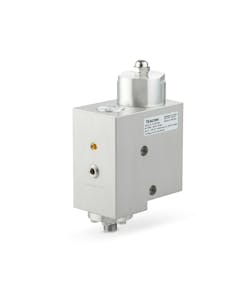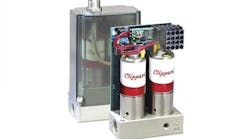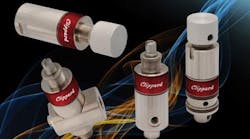TESCOM HV-7000 Series Two-Stage Pressure Regulator for Hydrogen Fuel Efficiency
The TESCOM HV-7000 Series 2-stage pressure-reducing regulator maximizes fuel efficiency and improves reliability in hydrogen-powered vehicles. Easy to install, the regulators provide stable pressure delivery, high reliability, and long service life for heavy-duty vehicles powered by fuel cells or hydrogen combustion engines.
The HV-7000 features 2-stage pressure reduction and a positive seal designed to deliver hydrogen to the fuel cell at optimal pressure in all flow conditions, even as the vehicle hydrogen storage tank depletes. The 2-stage pressure reduction significantly lessens decaying inlet characteristics compared to single-stage regulators, while the positive seal design offers superior shut-off performance. Together, these features can minimize fueling costs, as well as the risk of downstream component failure and downtime.
HV-7000 features tied valve stems, integrated filters, and patented redundant seals that make the regulator contamination-resistant, improving vehicle service life and extending time on the road.
The redundant seal design extends cycle life if one seal experiences wear; the filter catches solid particles produced during installation before they can contact soft goods, and the tied valve stem counteracts seat contamination and wear. Preventing contamination and resulting leaks can help avoid fuel loss, safety hazards, system damage, and equipment downtime.
In addition to its benefits for the vehicle user, the HV-7000 is also designed to help fuel cell system manufacturers and integrators assemble the regulator into their system as quickly as possible. The regulator is compact and lightweight, with a flat shape and mounting holes designed specifically for mounting the regulator against other flat surfaces in the system. Such easy installation helps reduce manufacturing and procurement costs and eases scale-up as production volumes increase compared to other pressure regulation technologies.
Features:
- Dual-stage pressure reduction minimizes decaying inlet characteristics and enables stable pressure delivery to fuel cell
- Redundant seal design and integrated filter ensure safety and reliability
- Superior shutoff performance and contamination resistance due to positive seal design
- Flow rate up to 5 g/s
- Wide outlet pressure range 10 to 30 bar (145 to 435 psi)
- Corrosion-resistant, anodized nickel-plated aluminum body
- Hydrogen-compatible materials
| Nom. Inlet Service Pressure | 700 bar (10,153 psi) |
| Max. Inlet Rated Pressure | 875 bar (12,691 psi) |
| Min. Inlet Pressure | At least 150% of outlet pressure |
| Design Proof Pressure | 150% of nominal inlet service pressure |
| Pressure Rating | Per Criteria of ANSI/ASME B31.3 |
| Outlet Pressure Range | 10 to 30 bar (145 to 435 psi) |
| Leakage | Bubble-tight |
| Operating Temp. | -40 to 185°F (-40 to 85°C) |
| Flow Capacity | Cv=0.17; 5 g H2/s |
| Decaying Inlet Characteristic | 6.2 mbar per 6.9 bar change in inlet pressure (0.09 psi per 100 psi change in inlet pressure) |
| Filter | 10 µm |
| Body | Aluminum 6061-T6 w/Clear Anodic Coating |
| Seat | Polyimide |
| O-Rings | Nitrile |
| Main Valve | 316 SST |
| Valve Spring | 316 SST |
| Piston | 316 SST |
| Sensor | Aluminum 6061-T6 |
| First & Second Stage Spring | 17-7 SST |
| Remaining Parts | 300 Series SST, Aluminum 60661-T6, Polyimide |
| Cleaning | CGA 4.1 and ASTM G93 |
| Weight | 3.5 lb. (1.6 kg) |





